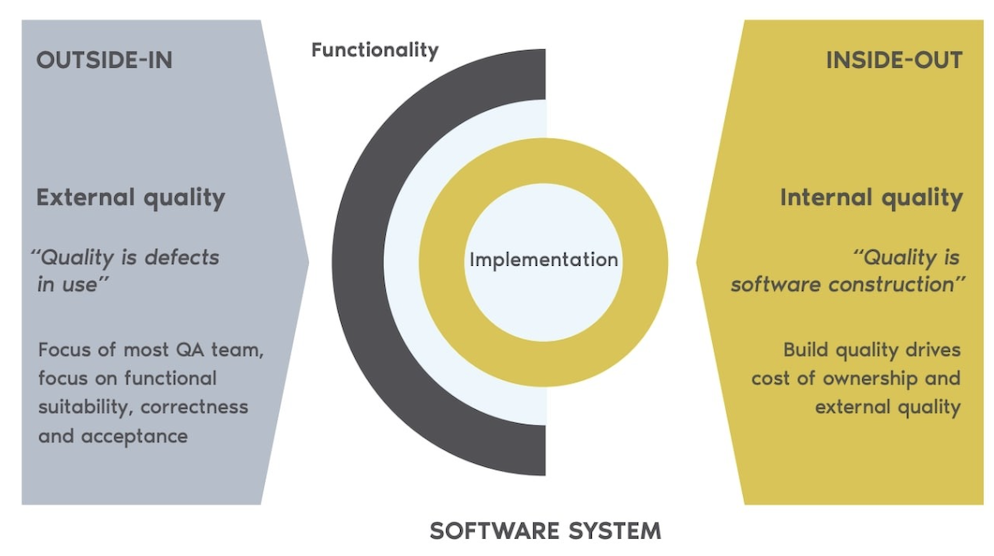Non-Functional Requirements: A Key Focus of Successful Software Quality Management
Summary
Functional requirements in software are those which deal with what a system does. Non-functional requirements concern how the system does it.
Testing these requirements is fundamental to the assured quality of your end product, and as such, it is equally important to devote time and resources to both functional and non-functional testing.
Software Quality Management (SQM) covers a series of processes dedicated to improving the quality and non-functional effectiveness of your software for better returns, improved security, greater maintainability, and reduced costs, among a myriad of other benefits.

Introduction
Software Quality Management (SQM) is the process of controlling, assuring, and planning the quality of your software systems.
You might think you yourself: “As long as my software systems do what they’re supposed to do, I’m good, right?”
Wrong.
But you’re not alone.
In fact, most Quality Assurance (QA) teams tend to focus on functional suitability, correctness, and acceptance of a software system. And the quality of a software system is simply defined by the absence of defects in use.
While this approach should definitely remain part of your software quality assurance processes, there is more to it. Our research shows that if you are only looking at software from the functional perspective, you will only be able to spot less than 10% of potential trouble.
This article explores functional and non-functional requirements, how testing these works, what their biggest differences are, and why integrating non-functional testing into SQM is vital for a successful long-term software quality management strategy.
Functional and non-functional requirements
Before diving into the specifics, it may be useful to begin with a brief recap of what we mean when we talk about ‘software requirements.’
In a nutshell: Requirements cover everything a system needs in order to function properly, meet end user demands, and do so in an efficient and effective way.
In simpler terms, functional requirements govern what a system does, while non-functional requirements dictate how the system does it.
Let’s take a closer look.
What are functional requirements?
Functional requirements are the set of requirements, processes, or objectives for a software system which specify what the system must do. They are usually dictated by end-user requirements.
For example, a music-sharing app may have functional requirements including:
- Ability to create user profiles
- Link to other music platforms for cross-pollination of artists and songs
- Option to create playlists
- Search function for music
- Play function for music
- Sharing and messaging platform for exchanging music with other users
Functional requirements are, in short, the requirements which must be met for a system to function properly, and as intended. Without them fulfilled, the system does not work.
What is functional testing?
To ensure functional requirements are met, functional testing must verify that each one has been properly developed. This process involves providing specific inputs and comparing actual outputs to expected results. Testing continues until all functional requirements are satisfactorily fulfilled.
What are non-functional requirements?
If functional requirements deal with what a software system should do, non-functional requirements concern how it does this, as well as how the system is built to support its outputs.

- The specifics of non-functional requirements generally cover aspects like:
- Maintainability: Similar to serviceability, maintainability dictates the ease with which a system can be fixed and managed—usually pertaining to the quality of the source code, the language in which it’s written, and the time it takes developers to access the system and solve faults found within, or edit it to meet new and future demands.
- Security: How open to security risks and vulnerabilities a product is, or rather, the degree to which the system is risk averse.
- Compatibility: Ensuring the product is compatible with necessary hardware and operating systems.
- Capacity: Determining the storage capacity of a system and its capacity to expand this in future.
- Availability: The speed with which the system is able to be brought back online following down-time, and the availability of the system to its end users.
- Scalability: The capacity of the system to scale with and function correctly under increased demand—i.e., how able a system is to deal with sudden surges in workload and user numbers.
- Environmental: Concerning the types of environments and their unique requirements in which the system is expected to perform.
- Performance: Performance as a non-functional requirement deals with the speed of the system, i.e., how quickly a system reacts to a user’s input.
- Regulatory compliance: How a system meets the specific regulatory requirements of an industry, state, or country.
Non-functional testing
Non-functional testing can be more complex than functional testing because it involves evaluating how the system’s source code and architecture support these qualities. By focusing on the system’s construction, non-functional testing ensures the long-term reliability and scalability of the software.
Functional vs non-functional requirements
In software development, functional testing often receives more attention than its non-functional counterpart because meeting critical requirements is considered more important than how they’re met. However, overlooking non-functional requirements means missing out on critical factors like security, scalability, and performance.
With the ever-increasing demands on software, managing quality in both functional and non-functional aspects is essential for ensuring the system’s long-term success.
In simpler terms: Please don’t just look at the car, also look under the hood.
We’ll examine specific examples of non-functional testing when we discuss its role in the success of Software Quality Management.

The role of non-functional testing in software quality management
The goal of Software Quality Management is to enable developers and IT leaders to optimize the development process, reducing Total Cost of Ownership (TCO) of their software portfolio, ensuring the security of their company and client data, making systems more valuable, manageable, and scalable.
Let us examine 11 of the most common non-functional testing examples and best practices for you to integrate into your own Software Quality Management.
1) Compatibility testing
Testing that your software is compatible with other software programs and systems—typically those most prevalent in your industry and/or relevant to your specific product.
2) Compliance testing
Testing that the system in development complies with all applicable local, industry, and/or international standards and regulations, such as Sarbanes-Oxley (SOX) or HIPAA.
3) Endurance testing
Testing the capacity of the software to handle a long and continuous load and still function. This is different to load testing, just as endurance training is different to strength training.
4) Load testing
Testing the ability of the software or system to handle large amounts of traffic, i.e., large numbers of users and transactions.
5) Performance testing
Testing the degree to which the software meets your various performance goals—such as latency under one second—helping you to identify performance bottlenecks and adjust the software accordingly.
6) Recovery testing
Testing to ensure that your system can be recovered following failure or data loss, such as an unexpected restarting of the hardware it’s operating on.
7) Security testing
Testing the security of the software from unauthorized access, attack, and other potential vulnerabilities. Non-functional testing in Software Quality Management is critical to improving the quality of your software and in doing so to reduce its vulnerability to security breaches.
8) Scalability testing
Testing whether the system can be scaled down or up to meet changing market demands or end-user needs.
9) Stress testing
Akin to endurance or load testing, stress testing tests the system’s capacity to withstand an unusually high load, such as unexpectedly large numbers of users trying to log into your app at the same time.
10) Portability testing
Testing how easily the software application or system can be moved between environments.
11) Internationalization testing
Testing the software’s ability to adapt to international cultures and languages, without having to modify its source code.

Conclusion
It can be tempting to allocate most of your software testing resources to the functional requirements of your systems, but this approach overlooks an equally critical factor in delivering secure, high-quality, cost-effective, and scalable software solutions—non-functional requirements.
Non-functional testing in Software Quality Management is fundamental to the success, ROI, and growth not only of your software portfolio, but also to your business as a whole.



